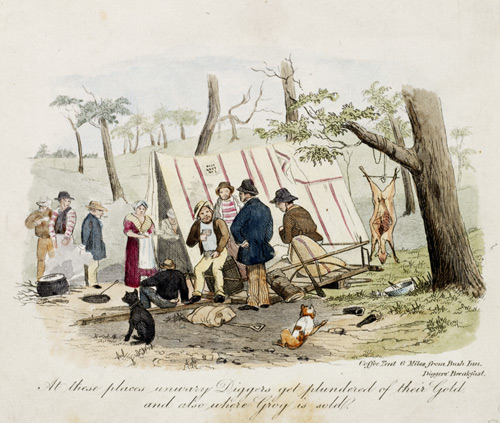Canvas Towns
The canvas town of Ophir had materialised overnight as tents were set up along the hillsides. It was winter when the diggers first began to move into areas north of Bathurst along the Turon River. There were reports of heavy frost and rain which quickly turned the diggings to mud. Diggers then moved on through out New South Wales as new goldfields were being opened up.
Gold diggers moved from Sofala, Gulgong, Hill End and Bathurst in the Central West of NSW south to new diggings at Lambing Flat (Young), Braidwood, Tilba Tilba and Kiandra in the Snowy Mountains. The short-lived gold rush at Kiandra was waylaid with heavy snowfalls in 1860. These adventurous diggers were some of the first to ski in the area, strapping wooden palings to their feet.
On the diggings there were no class barriers. Physical strength, health and determination were attributes that would bring the most reward. The only social distinction was between the old chums and the new chums.
The old chums were native born, or had lived in the colony for a long time, possibly ex-convicts. They considered themselves superior to the new arrivals and enjoyed the prestige of being experienced diggers. New chums tried valiantly to keep up, working diligently on their appearance so they looked like old chums; wearing dirty, battered cabbage-tree hats, growing their beards and moustaches long and ensuring they were proficient in colonial swearing habits.

Coffee tent six miles from Bush Inn. Diggers breakfast, 185?, by Samuel Thomas Gill
Coloured lithograph DL Q85/63/17
Initially alcohol was prohibited on the diggings and sly grog tents appeared along the gold fields. Owners caught selling illegally were given a 50 pound fine and a possible gaol term and had their stock confiscated. However, the demand on the goldfields was too tempting and the sly grog tents proliferated along the diggings. Eventually the government gave up its prohibition and granted licenses. Spirits were allowed to be sold by public houses which had officially paid the license fee to sell liquor. Pubs on or near the goldfields were successful as long as diggers were striking successful loads of gold in the area. After a few weeks steady business, the pub would have recouped the expensive license fee of around 100 pounds per year.
View photographs of businesses established in gold mining towns of Hill End and Gulgong
The one government measure to prevent chaos on the gold fields and a total exodus from the cities was to institute the licensing system for miners.
Find out more about the licensing system
Read some eye witness accounts from those who visited the diggings



